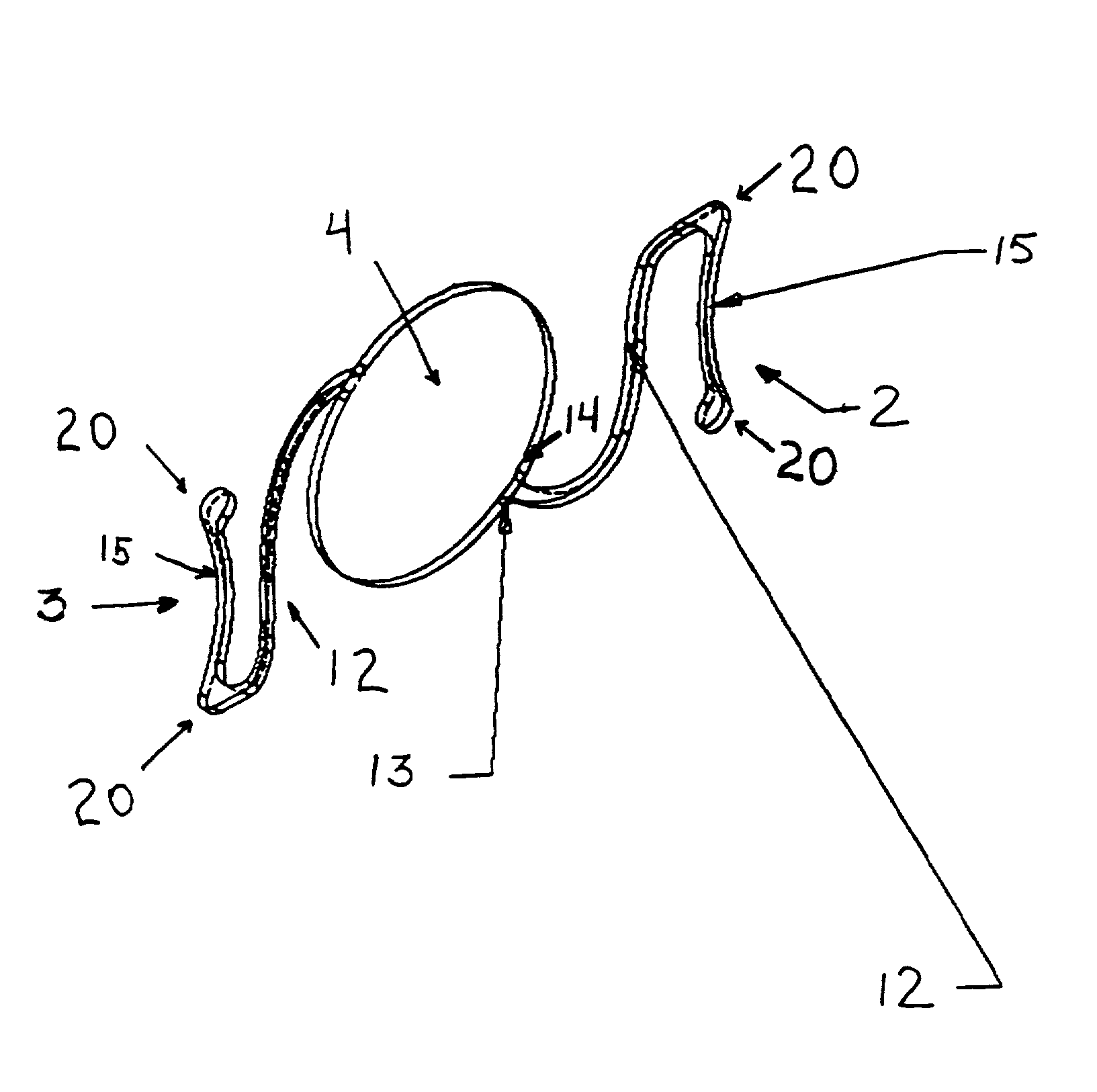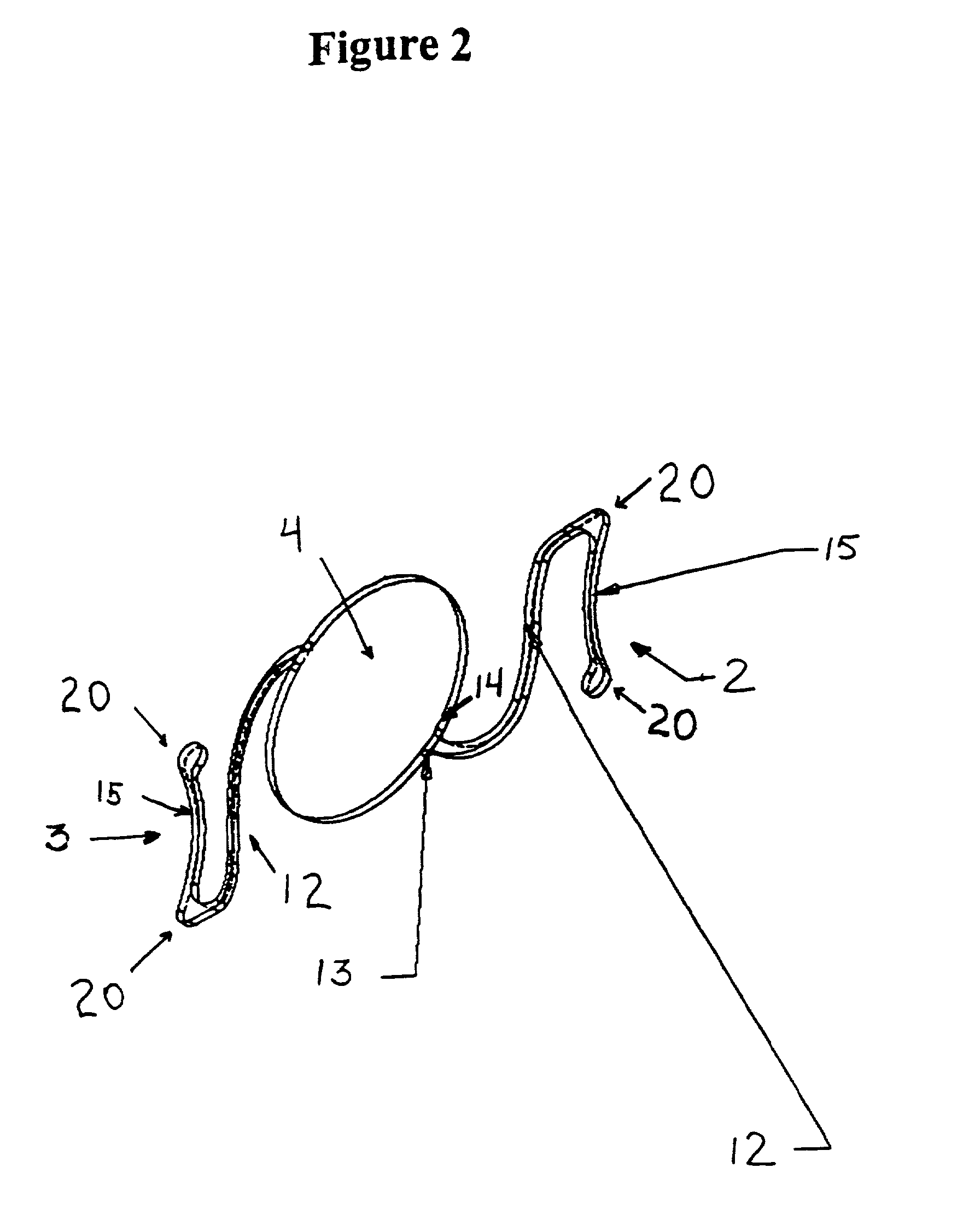Positive power anterior chamber ocular implant
a technology of ocular implants and anterior chambers, which is applied in the field of positive power anterior chamber ocular implants, can solve the problems of concomitant increase in damage to the eye, immediate or latent inflammation, and damage to the corneal endothelium
- Summary
- Abstract
- Description
- Claims
- Application Information
AI Technical Summary
Benefits of technology
Problems solved by technology
Method used
Image
Examples
example 1
[0053]Representative uncoated positive power ocular implants were made from polymethylmethacrylate (“PMMA”) each comprising an optic having a diameter of 6 mm and an omega value of 13 mm. The center thickness (TC) of the optical portion of each implant is shown in Table 1 below. The edge thickness (TE) of each optic was held constant at 0.220 mm. The posterior surface (RP) of each optic was kept planar. The anterior surface (RA) of each optic was convex, each having a degree of curvative shown in Table 1 below. The vault of each optic was set at 1.0 mm. The resulting degree of positive refraction is shown for each optic as indicated by its diopter value. The sagitta values of each provided optic are provided in Table 1. The haptics of each optic are made of PMMA and are in a four point “S” configuration. Each haptic has an intermediate beam length of 5.25 mm. The transition between the haptic and optic is normal to the optic, having a blend radius ranging in the horizontal and verti...
example 2
[0055]Representative implants of Table 1 were then tested for compression force, axial displacement, decentration, contact angle and optic tilt. Eighteen implants were made according to the specifications of Implant 1, described above in Example 1. Implants were exposed to a 0.5 mm diametral compression and a 1.0 mm diametral compression. The resulting mean and standard deviation values measured in grams are shown in Table 2 below.
[0056]
TABLE 2DiametralDiametralCompressionCompressionof 0.5 mmof 1.0 mmmeanstd devmeanstd devCompression Force0.1580.0310.4590.082Axial Displacement0.1120.0180.2450.030Decentration0.0820.0430.1220.077Contact Angle6.6570.0516.6940.085Optic Tilt0.9870.5060.7190.447
example 3
[0057]The present invention is further directed to a method of correcting refractivc errors caused by hyperopia by way of surgically implanting and anchoring a positive power anterior chamber ocular implant in the anterior chamber of the phakic eye in a subject in need thereof, wherein the positive artificial refracting lens has at least one convex surface and a means for positioning the positive refracting lens in the anterior chamber of the eye. By this method contact between the positive refractings lens and other anatomic bodies is avoided and the means for positioning the lens in the anterior chamber avoids contact with the iris and corneal endothelium.
[0058]Implants made in accordance with the present invention were surgically implanted into subjects having a natural lens in situ and anchored in the anatomic angle of the anterior chamber of the eye, according to traditional surgical techniques. The subjects were studied for inflamation and damage to the eye post insertion. No ...
PUM
| Property | Measurement | Unit |
|---|---|---|
| thickness | aaaaa | aaaaa |
| length | aaaaa | aaaaa |
| anterior chamber depth | aaaaa | aaaaa |
Abstract
Description
Claims
Application Information
 Login to View More
Login to View More - R&D
- Intellectual Property
- Life Sciences
- Materials
- Tech Scout
- Unparalleled Data Quality
- Higher Quality Content
- 60% Fewer Hallucinations
Browse by: Latest US Patents, China's latest patents, Technical Efficacy Thesaurus, Application Domain, Technology Topic, Popular Technical Reports.
© 2025 PatSnap. All rights reserved.Legal|Privacy policy|Modern Slavery Act Transparency Statement|Sitemap|About US| Contact US: help@patsnap.com



